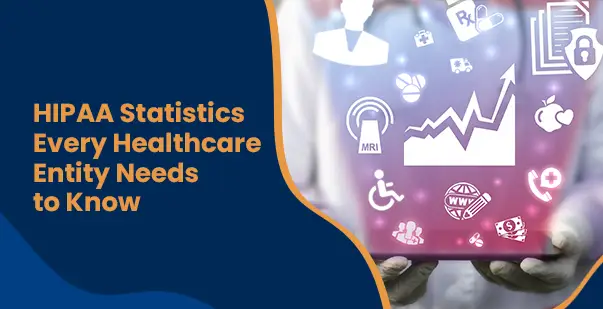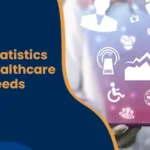How HIPAA Statistics Are Shaping Healthcare Security for 2025

September 30, 2025
A recent study published in May 2025 by JAMA Network Open reveals some eye-opening news: hacking now plays a part in 81% of all HIPAA-reported healthcare data breaches. That’s a huge shift, and it signals a whole new level of cybersecurity risk.
This article breaks down the most important HIPAA statistics healthcare professionals need to know. You’ll get a clear picture of where data breach threats are rising, why HIPAA compliance matters more than ever in 2025, and what you can do right now to better safeguard your patients’ information.
The May 2025 JAMA Network Open study reports that healthcare data breaches have more than doubled since 2010. Most striking of all, ransomware is now responsible for the majority of breached patient records, making it one of the leading threats to patient privacy today.
What Do the Latest HIPAA Data Breach Statistics Tell Us?
Healthcare data privacy is front and center as hospitals and clinics move more of their operations online. The volume of protected health information (PHI) being stored and shared has exploded. According to a 2025 JAMA Network study, the landscape of healthcare data breaches has changed drastically in just over a decade.
Back in 2010, there were only 216 reported data breaches involving PHI. But by 2024, this number shot up to 566, more than doubling over the 14-year period.
From Insider Missteps to Hacking Nightmares
We’re not just talking about more breaches, though. The real shift is in how these breaches are happening. In 2010, hacking and information technology (IT) issues accounted for just 4% of reported incidents. Fast-forward to 2024, and those same cyberattacks now represent 81% of all reported healthcare breaches.
Ransomware – A New Era for Data Threats
Another jump: ransomware – once unheard of in healthcare – affected nearly 7 in 10 breached records by 2024. That’s 69% of all patient data involved, according to HIPAA data breaches statistics.
The significance here goes beyond numbers. Ignoring these HIPAA statistics doesn’t just mean risking fines from regulators. It can erode patient trust – something that’s hard to rebuild after a breach makes headlines. That’s why smart healthcare leaders keep these statistics top of mind.
To really get a handle on where your organization’s risks are today, review your own breach data alongside these national HIPAA statistics – sometimes, the warning signs are right under your nose before they show up in a headline.
| Year | Total HIPAA Data Breaches | Main Cause of Breaches |
| 2010.0 | 216.0 | Mostly insider missteps; hacking/IT issues made up only 4% |
| 2024.0 | 566.0 | 81% due to hacking/IT incidents; ransomware involved in 69% of breached records |
| 2025 (insights) | Data breaches have more than doubled since 2010 | Ransomware is now a leading threat, responsible for most breached records |
How Are Hacking and Ransomware Changing HIPAA Risks?
Tech advances have made patient care smoother and info-sharing easier. But there’s a flip side.
Why Breaches Keep Happening
The mix of complicated healthcare IT systems and the use of digital records has left many organizations wide open to attacks. Handing off data to lots of third-party vendors only adds to the risk. Ransomware, in particular, has gone from being rare to completely disruptive.
Here’s why it’s worse than a regular hack: ransomware can both steal and lock your files. While you’re locked out, hackers can release sensitive health info online or on the dark web. The JAMA Network research confirms that since 2021, ransomware is causing the most harm by locking and leaking records on a large scale.
Security Is a Team Sport Now
These attacks used to be random, but now they come in waves – and they target hospitals, provider networks, and even remote telehealth teams. Basic IT security doesn’t cut it anymore. Today, you need multiple layers of defense, smarter monitoring, and a workplace culture that values privacy.
HIPAA data breach statistics show that regulatory compliance alone is only a starting point. Protecting patient data in 2025 means advanced security tech, better training, and leadership that sets a strong example.
One quick win: set up regular tabletop exercises simulating ransomware attacks, even if it feels awkward at first. Practicing your response with all key staff can reveal weak links before attackers do.
What Lessons Are Hidden in Recent HIPAA Enforcement Data?
Privacy issues don’t end at the US border. New reviews – like the June 2025 analysis from the National Institutes of Health – compare global privacy rules such as Europe’s General Data Protection Regulation (GDPR), the California Consumer Privacy Act (CCPA), and South Africa’s Protection of Personal Information Act (POPIA). US healthcare organizations struggle to keep up because each rule defines sensitive data a bit differently.
Gaps in Law and Technology
This patchwork of rules – and the language used to describe PHI – makes it tough for healthcare systems to know when and how to protect data. Cross-border healthcare and cloud tech only complicate matters. Some providers also lack the right IT tools to battle modern threats.
The Promise of Advanced Tech
On the plus side, new technologies promise real help. Artificial intelligence (AI), machine learning (ML), and blockchain aren’t just buzzwords – they can spot breaches sooner and automate security tasks. Strong HIPAA compliance stats show that these tools work, but only if supported by clear processes and policies.
Bottom line: staying secure means blending regulatory guidance, organization-wide privacy habits, and the latest security breakthroughs into one plan.
If you’re struggling with international privacy rules, try forming a cross-functional team – including legal, compliance, and IT folks – to map how each regulation affects your specific patient data flows. Getting everyone in a room can clear up a lot of confusion.
How Can Emerging Technologies Improve HIPAA Compliance in 2025?
Healthcare innovators are using synthetic data and privacy-first tools to try to limit risks. These new approaches get a lot of attention – but they’re not foolproof.
The Upside and Downside of Synthetic Data
A 2024 Nature Digital Medicine review examined privacy and utility metrics for synthetic health data generated by models like generative adversarial networks (GANs). These fake records can speed up innovation while limiting direct exposure of real patient details. But here’s the catch: there’s no industry-wide standard yet for checking how private – or useful – these synthetic records really are.
That means healthcare providers can’t assume synthetic data gets them off the hook for HIPAA compliance stats and enforcement data. These tools sometimes let stuff slip or miss the mark on security.
Covering All the Bases
So, what helps? Pairing new data tech with proven safeguards:
- Strong data encryption
- Careful control over who gets access to sensitive information
- Continuous staff training on privacy best practices
For now, treat synthetic data as just one tool in the arsenal – not a standalone solution. The real wins come from blending new methods with ongoing human oversight and organizational vigilance.
Don’t forget, even simple steps like updating and rotating passwords – especially for privileged system accounts – can protect your patients’ records just as much as the latest cutting-edge technology. Old-school methods still work if used right.
Which Action Steps Should Healthcare Organizations Take in 2025?
Even in the shadow of repeated data breaches, prioritizing HIPAA compliance still pays off for American healthcare organizations.
What Regulators Expect Now
The Department of Health and Human Services (HHS) and other federal agencies have ramped up enforcement – issuing more fines while also providing resources and training. HIPAA enforcement data points to a handful of practices that make a real difference:
- Regular system audits
- Well-prepared incident response drills
- Comprehensive security risk assessments
Earning Patient Trust
Quick, clear communication after an incident – letting patients and authorities know what’s happened – shows accountability and can actually rebuild trust.
Success depends on acting before problems strike. By reviewing HIPAA statistics, improving security tools, and fostering an accountable culture, healthcare organizations can stay ahead in the fight against healthcare data breaches 2025.
Consider setting up anonymous feedback tools where staff can report suspicious activity or privacy worries without fear – nipping small issues in the bud can prevent bigger breaches down the line.
Conclusion
Healthcare data privacy and HIPAA compliance are shifting fast. The latest HIPAA statistics underline not just bigger breach numbers, but smarter and more dangerous attacks led by hackers and ransomware.
Staying secure means more than checking boxes – organizations need to adapt, invest, and put privacy at the center of everyday decisions. IT, compliance leaders, and clinicians must work together with clear policies and strong tech, backed by global best practices.
Keep watching the latest HIPAA compliance stats, act on gaps quickly, and you’ll help your healthcare organization stay trusted while protecting the patients who count on you.
FAQs
Q: What are the latest HIPAA statistics about healthcare data breaches in 2025?
A: HIPAA data breaches statistics show cases rose from 216 in 2010 to 566 in 2024. Hacking and IT incidents are now 81% of all reported breaches, highlighting major cybersecurity challenges for healthcare organizations.
Q: How common are ransomware attacks in recent HIPAA compliance stats?
A: HIPAA statistics reveal ransomware attacks now impact 69% of all patient records. Ransomware accounted for 31% of 2021 breaches, and healthcare data breaches in 2025 continue to involve threats from evolving ransomware tactics.
Q: What global challenges affect HIPAA enforcement data?
A: HIPAA enforcement data shows regional differences in IT infrastructure and regulations contribute to inconsistent data privacy protection. Harmonizing global privacy standards remains crucial for reliable patient data security in 2025.
Q: What technology solutions address HIPAA data breaches statistics?
A: Advanced technologies like AI, ML, and blockchain help address healthcare data breaches in 2025 by improving security, data harmonization, and integrity, supporting efforts to meet HIPAA compliance stats and standards.





